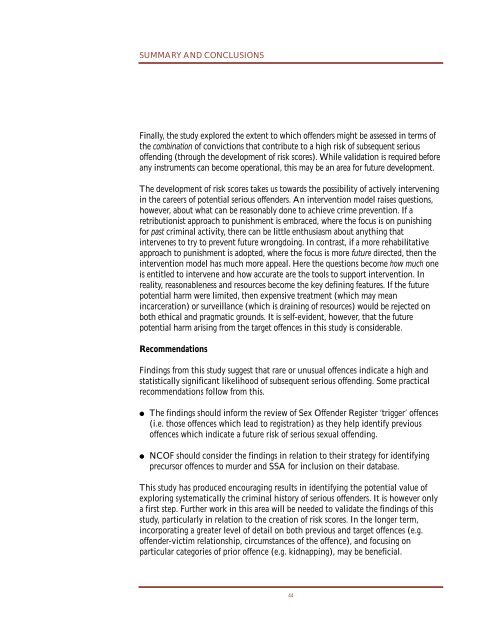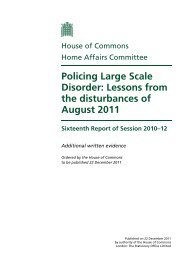Murder and Serious Sexual Assault - Lancaster EPrints - Lancaster ...
Murder and Serious Sexual Assault - Lancaster EPrints - Lancaster ...
Murder and Serious Sexual Assault - Lancaster EPrints - Lancaster ...
Create successful ePaper yourself
Turn your PDF publications into a flip-book with our unique Google optimized e-Paper software.
SUMMARY AND CONCLUSIONS<br />
Finally, the study explored the extent to which offenders might be assessed in terms of<br />
the combination of convictions that contribute to a high risk of subsequent serious<br />
offending (through the development of risk scores). While validation is required before<br />
any instruments can become operational, this may be an area for future development.<br />
The development of risk scores takes us towards the possibility of actively intervening<br />
in the careers of potential serious offenders. An intervention model raises questions,<br />
however, about what can be reasonably done to achieve crime prevention. If a<br />
retributionist approach to punishment is embraced, where the focus is on punishing<br />
for past criminal activity, there can be little enthusiasm about anything that<br />
intervenes to try to prevent future wrongdoing. In contrast, if a more rehabilitative<br />
approach to punishment is adopted, where the focus is more future directed, then the<br />
intervention model has much more appeal. Here the questions become how much one<br />
is entitled to intervene <strong>and</strong> how accurate are the tools to support intervention. In<br />
reality, reasonableness <strong>and</strong> resources become the key defining features. If the future<br />
potential harm were limited, then expensive treatment (which may mean<br />
incarceration) or surveillance (which is draining of resources) would be rejected on<br />
both ethical <strong>and</strong> pragmatic grounds. It is self-evident, however, that the future<br />
potential harm arising from the target offences in this study is considerable.<br />
Recommendations<br />
Findings from this study suggest that rare or unusual offences indicate a high <strong>and</strong><br />
statistically significant likelihood of subsequent serious offending. Some practical<br />
recommendations follow from this.<br />
● The findings should inform the review of Sex Offender Register ‘trigger’ offences<br />
(i.e. those offences which lead to registration) as they help identify previous<br />
offences which indicate a future risk of serious sexual offending.<br />
● NCOF should consider the findings in relation to their strategy for identifying<br />
precursor offences to murder <strong>and</strong> SSA for inclusion on their database.<br />
This study has produced encouraging results in identifying the potential value of<br />
exploring systematically the criminal history of serious offenders. It is however only<br />
a first step. Further work in this area will be needed to validate the findings of this<br />
study, particularly in relation to the creation of risk scores. In the longer term,<br />
incorporating a greater level of detail on both previous <strong>and</strong> target offences (e.g.<br />
offender-victim relationship, circumstances of the offence), <strong>and</strong> focusing on<br />
particular categories of prior offence (e.g. kidnapping), may be beneficial.<br />
44
















